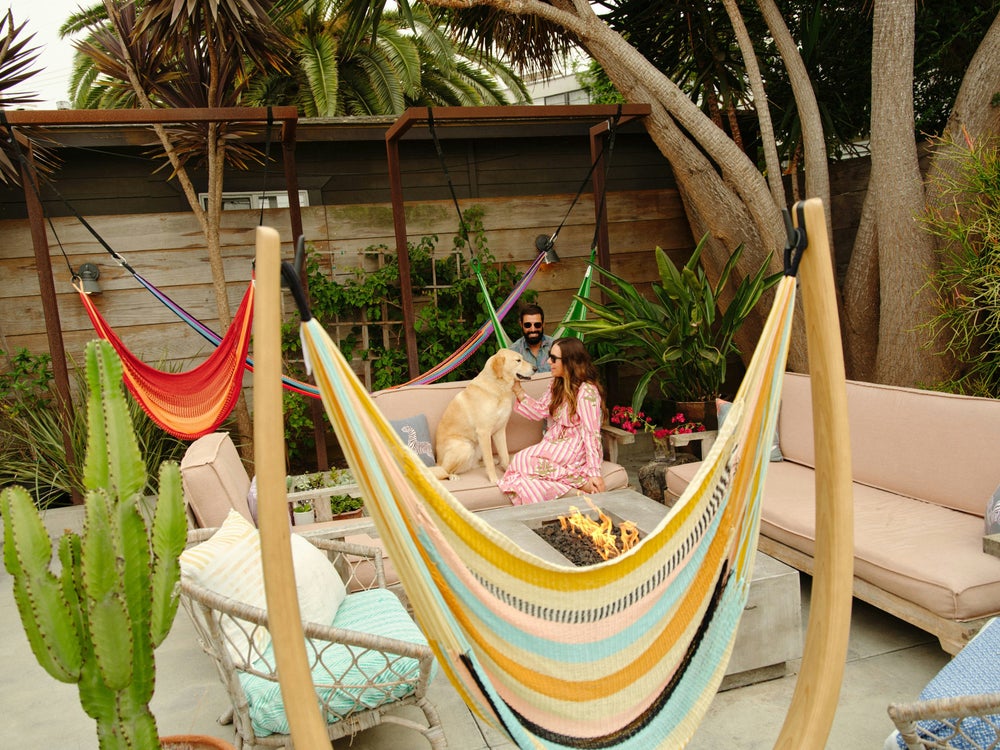This Couple Started a Side Hustle Out of Their Volkswagen. It Made $1 Million a Month Last Year and Is 'So Fulfilling.' Husband and wife Joe Demin and Rachel Connors are committed to building Yellow Leaf Hammocks — and supporting artisans in Thailand along the way.
By Amanda Breen Edited by Jessica Thomas
Key Takeaways
- The couple appeared on 'Shark Tank' during the pandemic, then pivoted their business from wholesale to DTC.
- They encourage aspiring BIZ Experiencess to know their numbers and listen to their customers.

This Side Hustle Spotlight Q&A features Los Angeles-based husband and wife Joe Demin and Rachel Connors, who co-founded Yellow Leaf Hammocks in 2011.
The couple bootstrapped their venture while selling hammocks out of the back of their Volkswagen and balancing day jobs. Yellow Leaf Hammocks made $1 million a month last year and has seen more than $30 million in lifetime sales. Responses have been edited for length and clarity.
What was your day job or primary occupation when you started your side hustle?
Joe worked in real estate finance, and Rachel in nonprofit fundraising.
When did you start your side hustle, and where did you find the inspiration for it?
JD: In 2011, I went on vacation to Thailand and discovered the world's comfiest hammock outside a tiny hut on an island in the Andaman Sea. After some inquiry, I found out that this hammock had been handwoven by women from an endangered hill tribe group in the jungle. I was intrigued and convinced a cabbie to drive me 600 miles to their village to meet these talented artisans. These women were creating incredible hammocks to help their families escape poverty, and I felt inspired by their hopes and dreams for the future. I wanted to support their vision and knew there was potential to build a brand that captured that magical "vacation feeling" I experienced my first time in a Yellow Leaf Hammock.
What were some of the first steps you took to get your side hustle off the ground?
RC: When Joe returned from his Thailand trip with a backpack full of hammocks and a business plan written on his airsickness bag, we primarily wanted to get feedback from potential customers. We took those original hammocks to a weekly arts market near our house, put up a tent and found ourselves face-to-face with our first customers. Each week, we would reinvest our profits into purchasing more inventory for the next fair. We sold our first 1,000 hammocks that way, asking tons of questions about what people wanted from their hammocks and learning what parts of our brand story resonated with them so that we could refine our product and marketing.
What were some of the biggest challenges you faced while building your side hustle, and how did you navigate them?
JD: Bootstrapping is hard work! Our tight budget in the early days was a major challenge, but we knew that we'd have more luck building our brand through earning revenue than spending time seeking investment in the early days. We knew our product was incredible, but we had to protect our mission by reaching a certain level of success before looking for investors.
RC: We had to learn a lot on the fly. We were like sponges soaking up knowledge about everything from textile engineering to wholesale pricing to coding a website. We went through a business incubator and began focusing on getting picked up by retailers; we collaborated with everyone from CB2 to Anthropologie to Tommy Bahama and built a great wholesale operation, but Covid destroyed our business with brick-and-mortar retailers.
 Image Credit: Courtesy of Yellow Leaf Hammocks
Image Credit: Courtesy of Yellow Leaf Hammocks
JD: When we got the opportunity to appear on Shark Tank in 2020, we moved quickly to transform ourselves into an ecommerce business. In a matter of months, we transitioned from a wholesale company to a DTC brand, which has enabled us to communicate more directly with our customers and build deeper relationships with our fans.
How long did it take you to see consistent monthly revenue? How much did the side hustle earn?
JD: We were cash-flow positive from day one, but it was very slow growth at first. We generated about $100,000 in the first year.
You've since turned the side hustle into a full-time business. What does growth and revenue look like now?
We've now done over $30 million in sales, sold to over 100,000 customers and employ hundreds of full-time artisans in rural Thailand.
What do you enjoy most about running this business?
RC: We love the creativity and day-to-day hustle of BIZ Experiencesship. The problem-solving never stops as you grow, but I believe truly creative people enjoy the act of creativity, not just the end result.
JD: It's so fulfilling to build a social enterprise that is transforming lives for our weavers and their families. We started out just trying to help a couple dozen women, and now we've trained hundreds of weavers and seen their kids grow up to go to college from hammock income!
What's your advice for others hoping to start successful side hustles or full-time businesses of their own?
JD: Know your numbers. They are the absolute lifeblood of your company. It doesn't matter how great your product is or how meaningful your mission is if you can't remain profitable and stay in business.
RC: Focus on your customer. Take every opportunity you can to solicit their opinions and ideas. Stay closely involved with customer service even as you grow because that's where you'll get those direct insights and be inspired to evolve and meet the needs of your fans.












